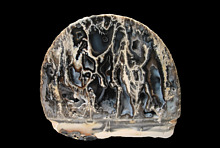Home PageAbout MindatThe Mindat ManualHistory of MindatCopyright StatusWho We AreContact UsAdvertise on Mindat
Donate to MindatCorporate SponsorshipSponsor a PageSponsored PagesMindat AdvertisersAdvertise on Mindat
Learning CenterWhat is a mineral?The most common minerals on earthInformation for EducatorsMindat ArticlesThe ElementsThe Rock H. Currier Digital LibraryGeologic Time
Minerals by PropertiesMinerals by ChemistryAdvanced Locality SearchRandom MineralRandom LocalitySearch by minIDLocalities Near MeSearch ArticlesSearch GlossaryMore Search Options
The Mindat ManualAdd a New PhotoRate PhotosLocality Edit ReportCoordinate Completion ReportAdd Glossary Item
Mining CompaniesStatisticsUsersMineral MuseumsClubs & OrganizationsMineral Shows & EventsThe Mindat DirectoryDevice SettingsThe Mineral Quiz
Photo SearchPhoto GalleriesSearch by ColorNew Photos TodayNew Photos YesterdayMembers' Photo GalleriesPast Photo of the Day GalleryPhotography
╳Discussions
💬 Home🔎 Search📅 LatestGroups
EducationOpen discussion area.Fakes & FraudsOpen discussion area.Field CollectingOpen discussion area.FossilsOpen discussion area.Gems and GemologyOpen discussion area.GeneralOpen discussion area.How to ContributeOpen discussion area.Identity HelpOpen discussion area.Improving Mindat.orgOpen discussion area.LocalitiesOpen discussion area.Lost and Stolen SpecimensOpen discussion area.MarketplaceOpen discussion area.MeteoritesOpen discussion area.Mindat ProductsOpen discussion area.Mineral ExchangesOpen discussion area.Mineral PhotographyOpen discussion area.Mineral ShowsOpen discussion area.Mineralogical ClassificationOpen discussion area.Mineralogy CourseOpen discussion area.MineralsOpen discussion area.Minerals and MuseumsOpen discussion area.PhotosOpen discussion area.Techniques for CollectorsOpen discussion area.The Rock H. Currier Digital LibraryOpen discussion area.UV MineralsOpen discussion area.Recent Images in Discussions
Mineralogical ClassificationIMA 2017-004 = katerinopoulosite
17th Oct 2018 20:13 UTCMarco E. Ciriotti Manager
Katerinopoulosite, a new picromerite-group mineral, was discovered in the Esperanza mine, Lavrion District, Attikí Prefecture, Greece. The new mineral occurs in the oxidation zone of a sphalerite-rich orebody in association with chalcanthite, nickelboussingaultite, ammoniojarosite, aurichalcite, and goethite. Katerinopoulosite forms white, pale blue or pale green vermiform polycrystalline aggregates, in fact, anthodite crusts with separate anthodites up to 3-cm long and up to 5-mm thick. The lustre is vitreous, and the streak is white. Katerinopoulosite is brittle, has Mohs hardness of 2½ and an uneven fracture. Neither cleavage nor parting is observed. Dmeas = 1.97(2) g/cm3, Dcalc = 1.986 g/cm3. The new mineral is optically biaxial (+), with α = 1.492(2), β = 1.496(2), γ = 1.502(2) (589 nm). 2V (meas.) = 80(5)°, 2V (calc.) = 79°. The infrared spectrum shows the presence of ammonium cations, sulfate anions, and water molecules. The chemical composition is (EDS-mode electron microprobe for Ni, Cu, and Zn; gas chromatography of ignition products for H, N and S, wt%): SO3 38.33, (NH4)2O 11.9, NiO 1.82, CuO 0.37, ZnO 16.83, H2O 29.4, total 98.65. The empirical formula based on 2 S atoms per formula unit (apfu) is H0.13(NH4)1.91(Zn0.86Ni0.10Cu0.02)(SO4)2.00·6.75H2O. Katerinopoulosite is monoclinic, P21/a, a = 9.230(6), b = 12.476(4), c = 6.249(4)Å, β = 106.79(5)°, V = 688.9(9)Å3, and Z = 2. The strongest lines of the powder X-ray diffraction pattern [d, A (I, %) (hkl)] are: 5.400 (37) (011), 4.411 (19) (200), 4.314 (19) (021), 4.229 (24) (12–1), 4.161 (100) (20–1, 210, 111), 3.749 (53) (130), 3.034 (29) (211, 11–2). The new mineral is named in honour of the prominent Greek geologist and mineralogist Prof. Dr. Athanassios Katerinopoulos. The type material is deposited in the collections of the Fersman Mineralogical Museum of the Russian Academy of Sciences, Moscow, Russia.
18th Oct 2018 02:00 UTCRonnie Van Dommelen 🌟 Manager
18th Oct 2018 10:46 UTCUwe Kolitsch Manager




Mindat.org is an outreach project of the Hudson Institute of Mineralogy, a 501(c)(3) not-for-profit organization.
Copyright © mindat.org and the Hudson Institute of Mineralogy 1993-2024, except where stated. Most political location boundaries are © OpenStreetMap contributors. Mindat.org relies on the contributions of thousands of members and supporters. Founded in 2000 by Jolyon Ralph.
Privacy Policy - Terms & Conditions - Contact Us / DMCA issues - Report a bug/vulnerability Current server date and time: April 25, 2024 05:11:01
Copyright © mindat.org and the Hudson Institute of Mineralogy 1993-2024, except where stated. Most political location boundaries are © OpenStreetMap contributors. Mindat.org relies on the contributions of thousands of members and supporters. Founded in 2000 by Jolyon Ralph.
Privacy Policy - Terms & Conditions - Contact Us / DMCA issues - Report a bug/vulnerability Current server date and time: April 25, 2024 05:11:01










